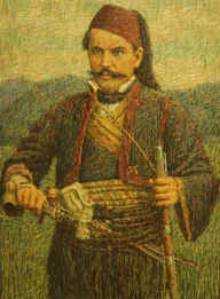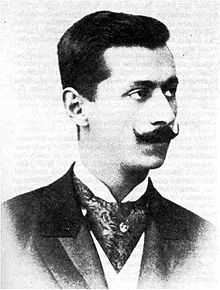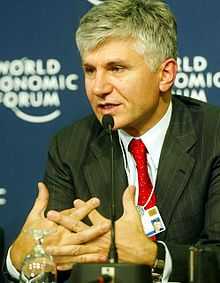Serbs of Bosnia and Herzegovina
| ||||||||||||||||||||||||||
| Total population | ||||||||||||||||||||||||||
|---|---|---|---|---|---|---|---|---|---|---|---|---|---|---|---|---|---|---|---|---|---|---|---|---|---|---|
| 1,366,104 (1991) | ||||||||||||||||||||||||||
| Regions with significant populations | ||||||||||||||||||||||||||
|
Republika Srpska: ~88% of population Federation of Bosnia and Herzegovina: ~3% of population | ||||||||||||||||||||||||||
| Languages | ||||||||||||||||||||||||||
| Serbian | ||||||||||||||||||||||||||
| Religion | ||||||||||||||||||||||||||
| Serbian Orthodox Church | ||||||||||||||||||||||||||
| Related ethnic groups | ||||||||||||||||||||||||||
| South Slavs | ||||||||||||||||||||||||||
The Serbs of Bosnia and Herzegovina are one of the three constitutive nations of the country, predominantly residing in the political-territorial entity of Republika Srpska. They are frequently referred to as Bosnian Serbs in English, regardless of whether they are from Bosnia or Herzegovina.
Demographics
The 1991 population census registered 1,366,104 Serbs or 31.2% of the total population of Bosnia and Herzegovina. Census was held in October 2013 with ethnicity data yet to be published. Bosnian Serbs are the most territorially widespread nation of Bosnia and Herzegovina. The vast majority live on the territory of the Republika Srpska, where they constitute around 88% of population. The majority of Bosnian Serbs are adherents of the Serbian Orthodox Church, while some are atheists. The Serbs of Bosnia and Herzegovina speak the Serbian language in its Ijekavian accent, similar to that of Serbs of Montenegro and Croatia.
History
Middle Ages
Slavs (Sclaveni) settled the Balkans in the 6th and 7th centuries. According to De Administrando Imperio (ca. 960), the Serbs had settled what is now Bosnia and Herzegovina. They inhabited and ruled "Serbia", which included "Bosnia" (with two inhabited cities; Kotor and Desnik), and the maritime principalities of Travunija, Zahumlje and Paganija, the first two having been divided roughly at the Neretva river (including what is today Herzegovina). Serbia was at the time ruled by the Vlastimirović dynasty. During the rule of Mutimir (r. 851-891), the Serbs were Christianized. The Serbs were important Byzantine allies; the fleets of Zahumlje, Travunia and Konavli (Serbian "Pomorje") were sent to fight the Saracens who attacked the town of Ragusa (Dubrovnik) in 869, on the immediate request of Basil I, who was asked by the Ragusans for help.[1] Prince Petar (r. 892-917), defeated Tišemir in Bosnia, annexing the valley of Bosna.[2] Petar took over the Neretva, after which he seems to have come into conflict with Michael, a Bulgarian vassal ruling Zahumlje (with Travunia and Duklja).[3] Prince Časlav Klonimirović (r. 927-960) managed to unite all mentioned Serb territories and established a state that encompassed the shores of the Adriatic Sea, the Sava river and the Morava valley as well as today's northern Albania. Časlav defeated the Magyars on the Drina river banks when protecting Bosnia, however, he was later captured and drowned in the Sava. After his death, Duklja emerged as the most powerful Serb polity, ruled by the Vojislavljević dynasty. Constantine Bodin (r. 1081–1101) installed his relative Stefan as Ban of Bosnia. Next, the Nemanjić dynasty acquired the rule of the Serbian lands. With the establishment of the autocephalous Serbian Church, Archbishop Sava founded the Metropolitanate of Zahumlje (1217–19).
Ottoman rule
With the Ottoman conquest of medieval Serbia, there were large migrations towards Bosnia and Herzegovina.
The Serb Uprising of 1596–97 was suppressed at Gacko.
In 1809, Jančić's Revolt broke out in Gradiška. In 1834, Priest Jovica's Revolt broke out in Gradiška. In 1858, Pecija's First Revolt broke out in Knešpolje. In 1875, the Herzegovina Uprising broke out in the Bosnia Vilayet. On July 2, 1876, Golub Babić and his 71 commanders signed the "Proclamation of the Unification of Bosnia with Serbia".
Austro-Hungarian rule
In 1878, Bosnia and Herzegovina became a protectorate of Austria-Hungary, which the Serbs strongly opposed. On June 28, 1914, Bosnian Serb Gavrilo Princip made international headlines after assassinating Arch Duke Francis Ferdinand in Sarajevo. This sparked World War I leading to Austria-Hungary's defeat and the incorporation of Bosnia and Herzegovina into the Kingdom of Yugoslavia.
World War II
During the World War II, Bosnian Serbs were put under the rule of the fascist Ustaša regime in the Independent State of Croatia. Under Ustaša rule Serbs along with Jews and Roma people, were subjected to systematic genocide where hundreds of thousands of civilian Serbs were murdered. According to the US Holocaust Museum, 320,000-340,000 Serbs were murdered under Ustasha rule.[4] According to Yad Vashem Holocaust Museum and Research Center,"More than 500,000 Serbs were murdered in horribly sadistic ways, 250,000 were expelled, and another 200,000 were forced to convert"[5] during WWII in the Independent State of Croatia (modern-day Croatia and Bosnia).
The May 1941 Sanski Most revolt against the Ustaša was suppressed in two days, and the June 1941 uprising in eastern Herzegovina was suppressed after two weeks.
Between 1945 and 1948, following World War II, approximately 70,000 Serbs migrated from the People's Republic of Bosnia and Herzegovina to Vojvodina after the Germans had left. Serbs were the larger of the two constitutive nations of Bosnia and Herzegovina (later the second largest of three, when Bosniaks, then known as Muslims by nationality, gained constitutive status in 1968).
Bosnian War

After the government of the Republic of Bosnia and Herzegovina declared independence, which was not accepted by the federal Serb controlled government of Yugoslavia, the Serbian Autonomous Area of the Bosnian Frontier was formed in the western Bosnian Frontier region of Bosnia and Herzegovina with its capital in Banja Luka, which was not recognised by the central government. SAO Bosnian Frontier made attempts to unite with the Autonomous Region of the Serbian Frontier in Croatia. The Serb political leadership martialled its own force assisted by the Yugoslav People's Army and declared independence from Bosnia and Herzegovina in late 1992. During this period there was notable support for the idea of a Greater Serbia being made reality, both within Bosnia and in Serbia proper. This ideology advocated the joining of Serb-populated regions into a contiguous territory. BiH's Bosniak and Bosnian Croat dominated government did not recognize the new Serbian Republic of Bosnia and Herzegovina, whose president was Radovan Karadžić seated in Banja Luka. The Serb side accepted the proposed ethnic cantonization of Bosnia and Herzegovina (the Carrington-Cutileiro peace plan), as did the Bosniak and Bosnian Croat sides in Lisbon in 1992, in the hope that war would not break out. The Bosniak political leadership under President Alija Izetbegović of Bosnia and Herzegovina subsequently revoked the agreement refusing to decentralize the newly created country based on ethnic lines. The Bosnian War began.
Throughout most of the war the Serbs fought against both the Bosniaks and the Bosnian Croats. During Bosniak-Croat hostilities the Serbs co-operated largely with the Croats. There were exceptions to this, however, as Serb forces were also allied with the pro-Yugoslav Bosniaks of the Autonomous Province of Western Bosnia under Fikret Abdić. Serb forces also carried out ethnic cleansing operations against non-Serbs living within their territory, the most formidable was the Srebrenica massacre in July 1995. During most of the war, the Serb Republic comprised around 70% of Bosnia and Herzegovina's soil. During the entire length of war the Army of the Serb Republic maintained the Siege of Sarajevo, allegedly in order to tie down the Bosnian Muslim (Bosniak) forces and resources in what was the capital of the Bosnian-Herzegovinian state. Serb Republic maintained close ties with the Republic of the Serb Frontier and received volunteers and supplies from the Federal Republic of Yugoslavia during the war. The Serb Republic received a large number of Serb refugees from other Yugoslav hotzones, particularly non-Serb held areas in Sarajevo, Herzeg-Bosnia and Croatia. In 1993, the Owen-Stoltenberg peace treaty was suggested that would give 52% of BiH to the Serb side. It was refused by the Bosniak side as too large of a concession.
In 1994, the Federal Republic of Yugoslavia imposed sanctions after the National Assembly of the Serb Republic refused the Vance-Owen peace plan. In 1995, Operation Storm eliminated the Republic of the Serb Frontier. The Croatian Army continued the offensive into the Serb Republic under General Ante Gotovina. Some 250,000 Serbs fled to the Serb Republic and Serbia from Croatia, as the Serb side continued a full retreat of Serbs from the Una to the Sana river. The Croatian Army, supported by the forces of the Muslim-Croat Federation of Bosnia and Herzegovina came within 20 km of the de facto Bosnian Serb capital, Banja Luka. The war was halted with the Dayton Peace Agreement which recognized Republika Srpska, comprising 49% of the soil of BiH, as one of the two territorial entities of the Republic of Bosnia and Herzegovina. The Serb side suffered a total 30,700 victims - 16,700 civilians and 14,000 military personnel, according to the Demographic Unit at the ICTY. Although exact numbers are disputed, it is generally agreed that the Bosnian War claimed the lives of about 200,000 people - Bosniaks, Croats and Serbs. More reliable numbers place the number of deceased during the war at around 100,000-104,000 (ICTY, 2011).See: Casualties of the Bosnian War
Culture
| Part of a series of articles on |
| Serbs |
|---|
 |
|
Native communities
|
|
Europe
Overseas
|
|
|
|
Related people |
The Serbs of Bosnia and Herzegovina speak the Eastern Herzegovinian dialect of Serbo-Croatian. They are predominantly Eastern Orthodox Christian, belonging to the Serbian Orthodox Church.
These Serbs are also known by regional names such as krajišnici ("frontiersmen" of Bosanska Krajina), semberci (Semberians), bosanci (Bosnians), hercegovci (Herzegovinians).
Traditional clothing
The dresses of Bosnia are divided into two groups; the Dinaric and Pannonian styles. In Eastern Herzegovina, the folk costumes are closely related to those of Old Herzegovina.
-

Dresses from East Herzegovina (left) urban Bosnia (right) 1875.
-

Serb costumes from Podgrmeč, Bosanska Krajina.
Notable people
See also
References
- ↑ http://www.rastko.rs/rastko-bl/istorija/corovic/istorija/2_4_l.html
- ↑ The early medieval Balkans, p. 148
- ↑ The early medieval Balkans, p. 149
- ↑ US Holocaust Museum, ushmm. "Jasenovac". US Holocaust Museum.
- ↑ "Independent State of Croatia" (PDF). Yad Vashem World Holocaust and Research Documentation Center.
| Wikimedia Commons has media related to Serbs of Bosnia and Herzegovina. |
| ||||||||||||||||||||||||







.jpg)











